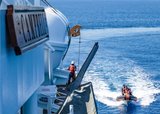DARPA issues RFI for technologies for ACTUV programme
The US Defense Advanced Research Projects Agency (DARPA) has issued a Request for Information (RFI) for its Anti-Submarine Warfare (ASW) Continuous Trail Unmanned Vessel (ACTUV) programme.
The RFI covers current technologies that could help ACTUV and future unmanned surface vessels perceive and classify nearby ships and other objects. This will help the programme comply with the International Regulations for Preventing Collisions at Sea (COLREGs). The programme aims to develop a new unmanned surface vessel to independently track ultra-quiet diesel-electric submarines over thousands of miles.
At present, ACTUV's system for vessel sensing is based on radar, which is less suitable for classifying the type of vessels being detected. The RFI aims to identify technologies that could help augment ACTUV's sensing and classifying capability and reduce reliance on radar as its primary sensor.
DARPA is specifically interested in sensor systems and image-processing hardware and software that use passive (electro-optical/infrared) or non-radar active (such as light detection and ranging) approaches. Its goal is to develop on-board systems to detect and track nearby surface vessels and potential navigation hazards, classify those objects' characteristics and provide input to ACTUV's autonomy software to facilitate correct COLREGs behaviour.
Scott Littlefield, programme manager, DARPA, said: 'We're looking for test-ready, multi-sensor approaches that push the boundaries of today's automated sensing systems for unmanned surface vessels.
'Enhancing the ability of these kinds of vessels to sense their environment in all weather and traffic conditions, day or night, would significantly advance our ability to conduct a range of military missions.'
The RFI invites short responses exploring some or all of the following technical areas: maritime perception sensors, maritime perception software and classification software for day shapes/navigation lights.
Responses are due by 28 April 2015.
DARPA signed a Memorandum of Agreement with the Office of Naval Research to jointly fund an extended test phase of an ACTUV prototype in September 2014. Pending the results of those tests, the programme could transition to the US Navy in 2018 for use in anti-submarine warfare and possibly as a multipurpose unmanned 'truck' for dirty, dull or dangerous missions, such as mine countermeasures.
More from Digital Battlespace
-
![Babcock nears first customer for Nomad AI translation tool]()
Babcock nears first customer for Nomad AI translation tool
Nomad can provide militaries with real-time intelligence, saving critical time on the battlefield.
-
![AUSA 2025: Israel’s Asio Technologies to supply hundreds of improved Taurus tactical systems]()
AUSA 2025: Israel’s Asio Technologies to supply hundreds of improved Taurus tactical systems
Taurus operates alongside the Israel Defense Forces’ Orion system which supports mission management across tens of thousands of manoeuvring forces, from squad leaders to battalion commanders.
-
![AUSA 2025: Kopin pushes micro-LED plans as China moves faster]()
AUSA 2025: Kopin pushes micro-LED plans as China moves faster
The plan for the new displays follows fresh investment in Kopin’s European facilities by Theon and an order for head-up displays in fielded aircraft, with funding from the US Department of Defense.
-
![AUSA 2025: Persistent Systems to complete its largest order by year’s end]()
AUSA 2025: Persistent Systems to complete its largest order by year’s end
Persistent Systems received its largest ever single order for its MPU5 devices and other systems earlier this month and has already delivered the 50 units to the US Army’s 4th Infantry Division.
-
![Aselsan brings in dozens of companies and systems under the Steel Dome umbrella]()
Aselsan brings in dozens of companies and systems under the Steel Dome umbrella
Turkey has joined the family of countries attempting to establish a multilayered air defence system with government approval in August 2024 for the effort landed by Aselsan. Dubbed Steel Dome, the programme joins Israel’s Iron Dome, the US Golden Dome, India’s Mission Sudarshan Chakra and South Korea’s low-altitude missile defence system.
-
![DSEI 2025: MARSS unveils new agnostic multidomain C4 system]()
DSEI 2025: MARSS unveils new agnostic multidomain C4 system
MARSS’ NiDAR system has been deployed using sensors from static platforms to provide detection and protection for static sights, such as critical infrastructure, ports and military bases.

























